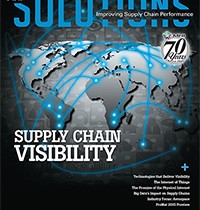Total Supply Chain Visibility
by George W. Prest Chief Executive Officer, MHI
Disruptive innovation and rising consumer expectations for anytime, anywhere service are stressing traditional supply chains to near-breaking points.
Companies who continue to utilize traditional supply chain models will struggle to remain competitive and deliver orders that are complete, accurate and on-time.
In fact, the U.S. Roadmap for Material Handling & Logistics predicts that traditional supply chain models will no longer exist by 2025.
The Report identifies a number of disruptors prompting this transformational change, and one of the big ones is total supply chain visibility.
The new issue of MHI Solutions focuses on innovative supply chain visibility solutions, from leveraging big data to the Internet of Things to the Physical Internet. These innovations are leading the way toward supply chains where all shipments are trackable in real-time by suppliers, manufacturers, shippers and receivers—from the instant of order to the instant of delivery.
This issue also previews ProMat 2015, the industry’s premier expo. ProMat 2015 will be the largest ProMat ever with over 800 exhibits covering 325,000 square feet. ProMat is where manufacturing and supply chain professionals come to discover the latest solutions and establish partnerships with key suppliers. They also come to learn and network with their peers in over 100 conference and networking sessions.
ProMat 2015 will be held March 23-26, which is great timing as the outlook is for continued growth in the U.S. economy for 2014 and 2015, according to our economic outlook article on page 45. During ProMat, MHI will release the 2015 MHI Annual Industry Report in collaboration with Deloitte Consulting LLP. The report will provide a greater understanding of the disruptive innovation that is transforming supply chains.
Topics will include:
1. 3D Printing
2. Predictive Analytics
3. Cloud Computing and Storage
4. Inventory and Network Optimization Tools
5. Wearable and Mobile Technology
6. Robotics and Automation
7. Driverless Vehicles and Drones
8. Sensors and Automatic Identification
How can you prepare to meet the challenges of the next decade? By fully embracing the changes driven by these disruptors. Simply investing in infrastructure, technology or human resources is not enough. Companies must formulate a strategic plan that includes core competencies and future business objectives, and is in step with the customer and the changing marketplace.
As the Industry That Makes Supply Chains Work, MHI pledges to be at the forefront of these developments through our Annual Industry Report and our Annual Conference in October. As we begin our 70th anniversary, MHI and our members continue to provide industry-leading resources and best-in-class equipment and systems to help companies deliver on the promise of maximum supply chain efficiency.
I hope this issue of MHI Solutions helps provide the information and resources you need to invest in the right innovations for your supply chain.





